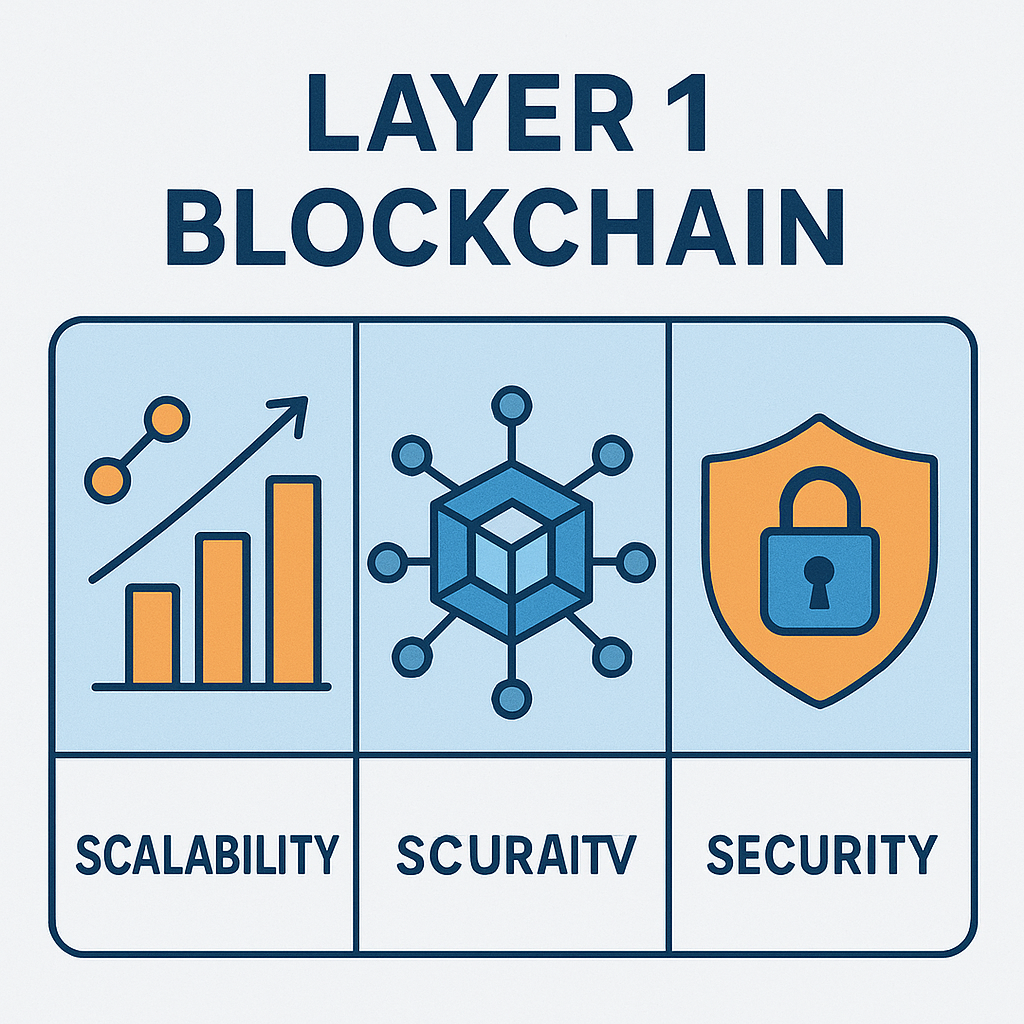The world of blockchain technology is evolving at a breathtaking pace, and understanding its layered architecture is now more important than ever. Whether you’re a crypto enthusiast tracking the latest bitcoin prices or a developer building decentralized applications, the concepts of Layer 0, Layer 1, and Layer 2 are shaping how we think about scalability and security in blockchain networks. These layers aren’t just technical jargon—they’re the foundation for solving some of crypto’s biggest challenges, from transaction bottlenecks to interoperability across different chains.

Why Do Blockchain Network Layers Matter?
Imagine the internet without its underlying protocols or physical infrastructure—websites wouldn’t load, emails wouldn’t send, and online banking would grind to a halt. Blockchain networks are similar: their layers define how data moves securely and efficiently. Each layer serves a unique purpose:
- Layer 0 blockchain: The foundational infrastructure enabling interoperability and cross-chain communication.
- Layer 1: The base protocol (think Bitcoin or Ethereum) where core consensus and transaction processing happen.
- Layer 2: Off-chain solutions that turbocharge scalability without sacrificing security.
This layered approach allows developers to innovate rapidly—without reinventing the wheel every time they want to improve speed or reduce costs. It’s also why projects like Polkadot, Cosmos, and Ethereum’s rollups have become hot topics on Crypto Twitter.
The Foundation: What Is Layer 0 Blockchain?
If you’ve ever wondered how blockchains like Polkadot or Cosmos enable different networks to “talk” to each other, you’re thinking about Layer 0 blockchain solutions. This is the bedrock beneath everything else—a set of protocols, hardware, and software that supports cross-chain transfers and communication. Think of it as the “internet of blockchains,” where multiple independent networks can interoperate safely.
Layer 0 isn’t just theoretical; it has real-world impact:
Leading Layer 0 Blockchains to Know
-

Polkadot: Connects multiple blockchains, enabling cross-chain transfers and shared security.
-

Cosmos: Focuses on interoperability, allowing different blockchains to communicate seamlessly.
-

Avalanche: Provides a highly scalable platform for custom blockchains and decentralized applications.
-

LayerZero: Specializes in lightweight, trustless cross-chain messaging to link various blockchains.
Projects at this level are focused on making blockchain ecosystems more connected and resilient. By providing a shared infrastructure for launching new blockchains (“parachains” in Polkadot’s case), they tackle one of crypto’s biggest hurdles: fragmentation. This not only boosts innovation but also lays the groundwork for truly scalable blockchain protocols that can support global adoption.
Layer 1: The Backbone of Security & Decentralization
Layer 1 blockchains are what most people picture when they think about cryptocurrencies—Bitcoin securing digital gold with proof-of-work; Ethereum powering DeFi with smart contracts. These base layers handle:
- Consensus mechanisms: Proof-of-work (PoW), proof-of-stake (PoS), or hybrids that validate transactions.
- Transaction settlement: Recording every transfer directly on the main chain for maximum transparency.
- Security guarantees: By decentralizing control among thousands of nodes worldwide.
The catch? As more users flood these networks, congestion leads to slower transactions and higher fees—a problem known as the “blockchain trilemma.” Developers face constant trade-offs between scalability, security, and decentralization. That’s why innovative tweaks like sharding (in Ethereum’s roadmap) or consensus upgrades (such as Cardano’s Ouroboros) are so hotly debated in the community.
Which blockchain layer will shape future scalability the most?
As blockchain technology evolves, different layers are being developed to tackle scalability challenges. Which layer do you believe will have the greatest impact on scaling blockchains in the future?
The Scalability Pressure Cooker: Why We Need More Than Just One Solution
No single layer can do it all—at least not yet! As demand for decentralized apps grows—from NFTs to cross-border payments—the need for scalable blockchain protocols has never been clearer. That’s where Layer 2 comes in… but before we dive into those game-changing solutions, let’s recap how these foundational layers interact:
Quick Comparison: Layer 0 vs Layer 1 vs Layer 2 in Blockchain Networks
| Feature | Layer 0 | Layer 1 | Layer 2 |
|---|---|---|---|
| Definition | Underlying infrastructure enabling multiple blockchains (e.g., interoperability protocols) | Base blockchain protocol (e.g., Bitcoin, Ethereum) | Protocols built on top of Layer 1 to enhance scalability |
| Main Purpose | Interoperability & connectivity | Security & consensus | Scalability & speed |
| Examples | Polkadot, Cosmos | Ethereum, Bitcoin, Solana | Polygon, Arbitrum, Lightning Network |
| Security | Depends on Layer 1 and own mechanisms | Highest (native consensus) | Inherits from Layer 1, may add own risks |
| Scalability | Enables multi-chain scaling | Limited by protocol design | Significantly increases throughput |
| Trade-offs | Complexity, early stage adoption | Scalability limits, slower upgrades | Potential security risks, reliance on Layer 1 |
| Typical Users | Developers building new blockchains | End-users & dApps | dApps needing faster/cheaper transactions |
This interplay between layers is what makes modern blockchains so dynamic—and so full of potential for both builders and investors alike. Next up: how off-chain scaling solutions are rewriting what’s possible for speed and cost-efficiency in crypto transactions!
As the blockchain ecosystem evolves, understanding how each network layer operates—and how they interact—is essential for grasping the ongoing push toward both scalability and robust security. Let’s dive deeper into what distinguishes Layer 0, Layer 1, and Layer 2, and why their interplay is so vital for the future of decentralized technologies.
Layer 0: The Hidden Backbone of Blockchain Networks
Often overlooked in mainstream discussions, Layer 0 blockchain solutions serve as the foundational infrastructure upon which all other blockchain network layers are built. Think of Layer 0 as the “internet” for blockchains—a protocol that enables various chains to communicate, share data, and even transfer assets seamlessly. This layer includes underlying protocols, consensus engines, networking hardware, and cross-chain communication tools.
Projects like Polkadot and Cosmos exemplify Layer 0 innovation by providing interoperability between otherwise siloed blockchains. Their goal? To solve fragmentation in the Web3 universe by letting assets and data flow freely across networks while maintaining high security standards.

This foundational role makes Layer 0 indispensable for building truly scalable blockchain protocols—without it, every chain would be an isolated island.
Layer 1: Where Security Meets Decentralization
Layer 1, or the base protocol layer, is where most users interact with blockchain technology directly. This is where you’ll find household names like Ethereum, Bitcoin, and other major chains. These networks focus on decentralization and security through consensus mechanisms such as Proof of Work (PoW) or Proof of Stake (PoS).
The challenge? As adoption grows, these protocols often struggle with throughput—resulting in slow transaction times or high fees during peak periods. However, their uncompromising approach to consensus ensures that every transaction is validated by a global network of nodes, making them highly resilient to attacks or manipulation.
| Layer | Main Function 🚀 | Examples 🔗 |
|---|---|---|
| Layer 0 | Cross-chain infrastructure & interoperability | Polkadot, Cosmos |
| Layer 1 | Main blockchain protocol (security & decentralization) | Bitcoin, Ethereum |
| Layer 2 | Scalability solutions built on top of L1s | Polygon, Lightning Network (BTC) |
The Role of Layer 2: Unlocking Scalability Without Sacrificing Security
This brings us to Layer 2 solutions—a critical piece for scaling blockchain networks without compromising their core values of security and decentralization.
L2 protocols operate atop existing blockchains (L1s), handling transactions off-chain or bundling them before submitting a summary back to the base layer. Examples include rollups on Ethereum (such as Optimism or Arbitrum), sidechains like Polygon, or payment channels like Bitcoin’s Lightning Network.
- L2s dramatically increase transaction throughput—sometimes processing thousands per second compared to L1’s much lower limits.
- This reduces congestion and slashes transaction fees for end users.
- L2s inherit the underlying security guarantees from their parent L1 chain while adding extra efficiency layers above it.
The magic of Layer 2? It lets us dream bigger: NFT gaming at scale, microtransactions without insane gas fees, and global DeFi access—all while keeping our assets secure on trusted base chains.
The Interconnected Future: Why These Layers Matter Together
No single layer can solve every challenge in blockchain alone. Instead:
- L0 lays down the tracks for interoperability;
- L1 ensures rock-solid trustlessness;
- L2 turbocharges speed and accessibility.
This layered architecture is what allows today’s most ambitious crypto projects to aim for mass adoption without sacrificing core principles. For instance, Ethereum’s roadmap now relies heavily on rollups (L2) while exploring interchain bridges (L0) to stay competitive in a multichain world—a sign that modularity is here to stay.
If you’re curious about how these layers stack up against each other—or want to know which solution might best fit your project’s needs—here’s a quick comparison:
Which blockchain layer will drive mainstream adoption?
As blockchain technology evolves, different network layers play unique roles in scalability and security. Which layer do you think will have the greatest impact on bringing blockchain to the masses?
The conversation around blockchain network layers isn’t just technical; it’s shaping how we imagine finance, governance, gaming, social media—and much more—in a digitally native world. Stay tuned as we explore specific use cases powered by this layered revolution!
As blockchain technology rapidly evolves, the interplay between Layer 0 blockchain infrastructure, robust Layer 1 protocols, and agile Layer 2 scaling solutions is shaping a new era of scalability and security. While technical jargon can be intimidating, understanding how these blockchain network layers work together is key to appreciating the innovation behind your favorite crypto projects.
How Layered Architectures Solve Scalability Bottlenecks
The infamous “blockchain trilemma”—balancing security, decentralization, and scalability—has driven much of the recent progress across all layers. Each layer plays a unique role in overcoming these limitations:
How Blockchain Layers Boost Scalability & Security
-

Layer 0: The Foundation for InteroperabilityLayer 0 protocols connect different blockchains, enabling cross-chain communication and shared security. This foundational layer helps networks scale by allowing them to work together seamlessly.
-

Layer 1: The Core Blockchain ProtocolLayer 1 is the main network (like Bitcoin or Ethereum) where transactions are processed and recorded. Security is ensured through consensus mechanisms, while scalability is addressed via upgrades like sharding or proof-of-stake.
-

Layer 2: Scaling Solutions Built on TopLayer 2 solutions (like rollups or state channels) process transactions off the main chain, then record results back to Layer 1. This approach reduces congestion and lowers fees while still benefiting from Layer 1 security.
Layer 0 projects like Polkadot and Cosmos enable cross-chain communication and interoperability at the protocol level. By allowing different blockchains to interact seamlessly, they open up possibilities for scalable decentralized applications that aren’t confined to a single ecosystem.
Layer 1, the “base layer,” includes blockchains like Bitcoin and Ethereum. These networks are responsible for fundamental consensus mechanisms—think proof-of-work or proof-of-stake—and provide high security by recording all transactions directly on-chain. However, as demand grows, transaction throughput often becomes a bottleneck.
This is where Layer 2 scalability solutions shine. Technologies like rollups (Optimistic and ZK), payment channels (Lightning Network), and sidechains process transactions off the main chain before settling them in batches back on Layer 1. This dramatically boosts throughput while preserving the underlying security guarantees.

The Real-World Impact: Security Meets Speed
The synergy between layers is transforming user experiences across DeFi, NFTs, gaming, and beyond. For example:
- Ethereum’s L2 rollups have slashed transaction costs for NFT minting and DeFi swaps.
- Bitcoin’s Lightning Network enables instant micropayments with near-zero fees—a game-changer for global remittances.
- Polkadot’s relay chain, as a Layer 0 solution, empowers new blockchains (parachains) to launch with shared security but independent rulesets.
This layered approach also lets developers choose their preferred trade-offs: maximum decentralization on mainnet or lightning-fast transactions via L2s—without sacrificing overall ecosystem integrity.
Navigating Blockchain Security Solutions Today
No discussion of blockchain network layers is complete without addressing security. Each layer brings its own set of challenges:
- Layer 0: Must ensure secure cross-chain messaging to prevent exploits that could affect multiple networks at once.
- Layer 1: Relies on time-tested consensus protocols but can be vulnerable to attacks if decentralization drops or if bugs exist in core codebases.
- Layer 2: Needs robust cryptography (like zero-knowledge proofs) to guarantee that off-chain computations are valid before being settled back on L1.
The best scalable blockchain protocols are those that treat each layer as part of a holistic system—designing interoperability features at Layer 0 while rigorously testing smart contracts at Layers 1 and 2. Community-driven audits, bug bounties, and constant upgrades are essential parts of this process.
Your Role in the Future of Blockchain Layers
If you’re an investor or builder navigating this landscape, staying informed about new developments in Layer-0 networks, emerging L1 chains (Solana, Cardano, etc.), or breakthrough L2 solutions (Arbitrum, zkSync) will help you spot opportunities early. The next wave of dApps may leverage fluid interactions between all three layers for unprecedented speed and reliability.
Which blockchain network layer excites you the most?
Blockchain technology is evolving fast, with different layers driving innovation. Which layer do you find most promising for the future of scalability and security?
The future isn’t about choosing one layer over another—it’s about harnessing their combined strengths for seamless user experiences across Web3. As research accelerates and adoption grows, expect even more creative hybrid solutions blurring traditional boundaries between infrastructure layers.
The bottom line? The evolution from monolithic chains toward modular architectures is unlocking new frontiers in both scalability and security. Whether you’re minting NFTs or building cross-chain DeFi apps, understanding these blockchain network layers will empower you to make smarter decisions—and participate confidently in crypto’s next chapter.






